Timing of ischemic insult alters fetal growth trajectory, maternal angiogenic balance, and markers of renal oxidative stress in the pregnant rat
- PMID: 22832532
- PMCID: PMC3468444
- DOI: 10.1152/ajpregu.00250.2012
Timing of ischemic insult alters fetal growth trajectory, maternal angiogenic balance, and markers of renal oxidative stress in the pregnant rat
Abstract
Increased uterine artery resistance and angiogenic imbalance characterized by increased soluble fms-like tyrosine kinase-1 (sFlt-1) and decreased free vascular endothelial growth factor (VEGF) are often associated with placental insufficiency and preeclampsia but not synonymous with hypertension. We hypothesized chronic reductions in utero-placental perfusion (RUPP) for 5 days (d) during either mid- (d12-d17) or late (d14-d19) gestation would have disparate effects on plasma sFlt-1 and VEGF levels and blood pressure. Five days of chronic RUPP was achieved by placement of silver clips on the abdominal aorta and ovarian arteries on either gestational d12 or d14. Arterial pressure was increased (P < 0.05) in RUPP vs. normal pregnant (NP) in both d17 (10%) and d19 (25%) groups, respectively. Circulating free VEGF was decreased (P < 0.05) and sFlt-1:VEGF ratio increased (P < 0.05) after 5 days of RUPP ending on d19 but not d17 compared with NP controls. Angiogenic imbalance, measured by an endothelial tube formation assay, was present in the d19 RUPP but not the d17 RUPP compared with age-matched NP rats. Five days of RUPP from days 14 to 19 decreased fetal and placental weights 10% (P < 0.01) compared with d19 NP controls. After 5 days of RUPP, from days 12 to 17 of pregnancy, fetal weights were 21% lighter (P < 0.01) compared with d17 NP controls, but placental weight was unchanged. These findings suggest that the timing during which placental insufficiency occurs may play an important role in determining the extent of alterations in angiogenic balance, fetal growth restriction, and the severity of placental ischemia-induced hypertension.
Figures
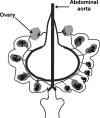
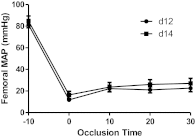
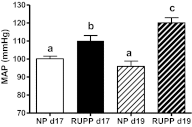


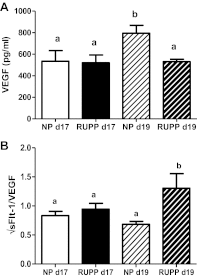
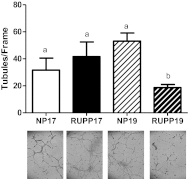

References
-
- Akolekar R, Syngelaki A, Sarquis R, Zvanca M, Nicolaides KH. Prediction of early, intermediate and late pre-eclampsia from maternal factors, biophysical and biochemical markers at 11–13 weeks. Prenat Diagn 31: 66–74, 2011 - PubMed
-
- Alexander BT, Kassab SE, Miller MT, Abram SR, Reckelhoff JF, Bennett WA, Granger JP. Reduced uterine perfusion pressure during pregnancy in the rat is associated with increases in arterial pressure and changes in renal nitric oxide. Hypertension 37: 1191–1195, 2001 - PubMed
-
- Alexander BT, Llinas MT, Kruckeberg WC, Granger JP. l-arginine attenuates hypertension in pregnant rats with reduced uterine perfusion pressure. Hypertension 43: 832–836, 2004 - PubMed
-
- Banek CT, Gilbert JS. Approaching the threshold for predicting preeclampsia: monitoring angiogenic balance during pregnancy. Hypertension 58: 774–775, 2011 - PubMed
Publication types
MeSH terms
Substances
Grants and funding
LinkOut - more resources
Full Text Sources
Medical
Miscellaneous

